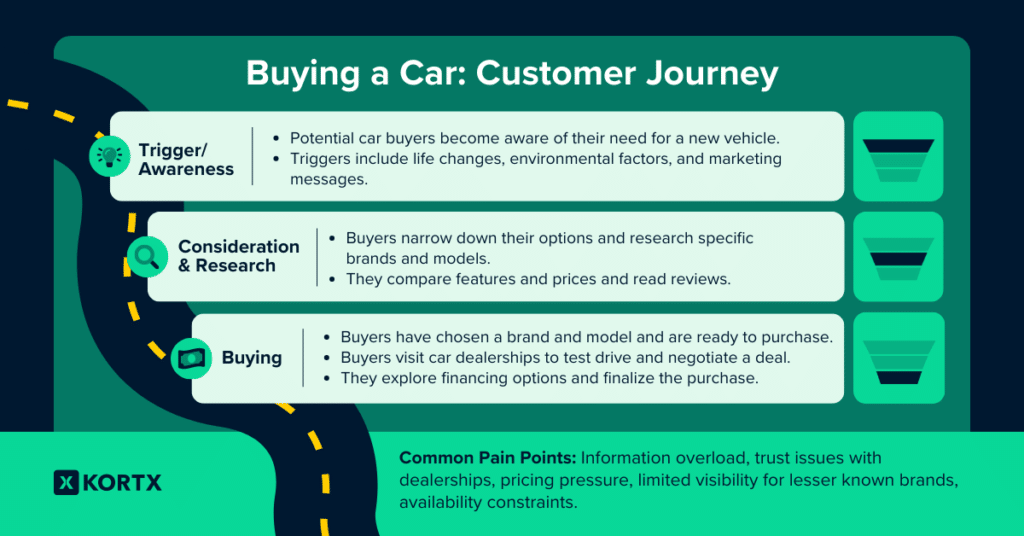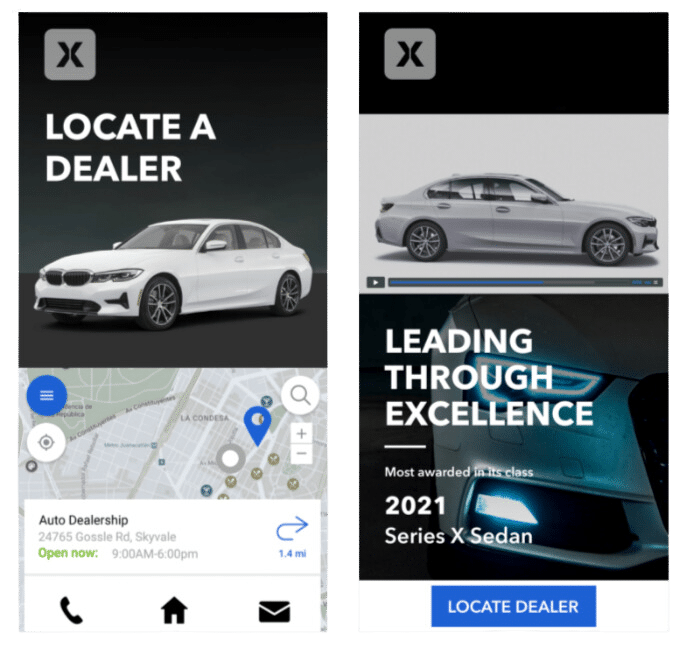Digital marketing has become an essential component of the automotive industry. However, with the complexities of coordinating strategies across different tiers, ensuring that the messaging reaches potential buyers at the right time can be challenging. At KORTX, we understand these challenges and work with multiple global auto brands to provide tailored digital media strategies that drive measurable success.
This blog will discuss the importance of a comprehensive digital marketing strategy for automotive brands, how audience discovery can help transform your campaign by reaching the right audiences, and how to keep messaging consistent from manufacturer to dealer offers.
Car Buying: Your Customer’s Journey
The automotive buying journey can be divided into four stages: trigger or awareness, consideration and research, and buying. In each stage, potential car buyers have different needs and priorities. As a digital marketer, it’s important to understand each step and how to effectively reach potential buyers.

Trigger (Top of Funnel)
Potential car buyers in this stage are becoming aware of their need (or want) for a new vehicle.
Triggers can come from various sources, including:
- Life Changes: Events such as a new job, starting a family, a totaled car or moving to a new city can all trigger the need for a new vehicle.
- Environmental Factors: An increase in gas prices, a desire for a more eco-friendly car, or a change in the weather/their location can all trigger a potential car buyer to consider their options.
- Marketing Messages: A catchy ad on social media or a TV commercial can plant the idea of purchasing a new car in a potential buyer’s mind.
Awareness (Top of Funnel)
In this stage, potential car buyers are starting to become aware of various brands and models to determine which would best suit their needs. If a buyer is not actively looking for a new car, marketing messages in this stage can create a trigger, pushing them further down the funnel into wanting to buy a new vehicle.
During this phase, buyers are starting to think about what they will want out of a new vehicle. This is where they make more general decisions about their car basics such as electric/hybrid vehicles vs. traditional cars, size of the vehicle (SUVs vs. cars), their overall budget, and important features (four-wheel drive, bluetooth, etc.).
Common marketing channels used in this stage include:
- Connected TV: Ads streaming during popular shows help pique interest in new vehicles and brands with consumers.
- Programmatic Audio: Audio is an ideal spot to advertise vehicle brands and deals. While the visual element is lost, this is the main channel that takes place IN the user’s vehicle.
- Online Video: Ads before and after online videos can also help drive brand awareness. Additionally, these can be shown to targeted audiences who might have an affinity for certain vehicle types.
Consideration and Research (Middle of Funnel)
At this stage, potential car buyers have narrowed their options to specific brands and models. They are researching in-depth to compare features and prices and read more reviews.
Common marketing channels used in this stage include:
- Comparison sites: Potential car buyers can use comparison sites such as Edmunds or Kelley Blue Book to compare different models and features.
- Retargeting ads: Brands can use them to remind potential buyers of their products after visiting their website. These ads can be displayed on various platforms like Facebook or Google.
- Content marketing: Brands can create informative blog posts or videos that educate potential buyers on different models and features. This content can help establish the brand as a thought leader and build trust with potential buyers.
🚗 What are some key considerations for digital marketers when potential car buyers enter the consideration phase?
“When potential car buyers enter the consideration phase, it is crucial to highlight the value propositions or high selling points of each brand and vehicle. This is the phase in which our audience is actively in-market for a car and will be most interested in the “why?” When planning for this phase, things to keep top of mind include: “What can this vehicle do for you?” or “Why is this vehicle the best fit for you?”

Buying (Bottom of Funnel)
At this stage, potential car buyers have decided on a specific brand and model and are ready to purchase. During this stage, buyers are looking for where to buy their car and where to get the best deal.
It is crucial to note that during this stage, buyers are also often researching financing options.
Standard options used in this stage include:
- Dealerships: Potential buyers often visit a dealership to take a test drive and negotiate a deal.
- Custom online ordering: Many manufacturers and dealerships offer the option to order a new vehicle online, allowing buyers to customize their vehicle (color, features) and making the process more convenient for potential buyers.
- Buying online: Over the past few years, customers have chosen to opt out of the dealership process and buy cars online from third parties.
🚗 What are some key considerations for digital marketers when potential car buyers enter the purchase phase?
“Marketers should have a compelling offer message that breaks through the clutter when entering the purchase phase. It’s essential to capture the user’s attention with a message that resonates with them, not just a generic message about finance rates. Brands can create a sense of urgency and encourage users to act by highlighting unique value propositions such as limited-time incentives, exclusive bonuses, or personalized benefits tailored to the customer’s needs.”

Pain Points for Car Buyers
The process of buying a car is harrowing for many purchasers. An automobile is one of the biggest purchases a person can make. Digital marketers who consider the following pain points when selling to their customers will be at an advantage.
- Information Overload: Customers feel overwhelmed by the abundance of information about different brands and models, making it challenging to research and compare options.
- Trust Issues: Customers struggle to find trustworthy reviews and recommendations, leading to uncertainty and hesitation in purchasing.
- Pricing Pressure: Customers experience uncertainty in negotiating a fair price and feel pressure to pay more than they can afford, making the buying process stressful and frustrating. This is also why many customers turn to online ordering or purchases over dealer lots.
- Limited Visibility: Customers have limited awareness of lesser-known brands and models that may better suit their needs and budget, potentially causing them to overlook viable options.
- Availability Constraints: Customers may face difficulty finding specific models in their area, potentially leading to frustration and a prolonged search for the desired vehicle.
Automotive Digital Marketing Tiers
Automotive digital marketing strategy is divided into three tiers based on where a customer is in their journey. This tiered approach caters to every stage of the customer’s buying journey. From building brand awareness to the crucial moment of purchase intent, each tier has its objectives, targeting techniques, and recommended channels.
Breaking the buying journey into tiers (and marketing stakeholders) offers a strategic approach to reach the right audience at the right time with the right message, from the earliest stage of brand awareness to the final moments of purchase intent.
Tier 1: Manufacturer & OEM Digital Marketing

The primary objective for Tier 1 automotive marketing is to raise awareness by reaching new audiences. This can be achieved by utilizing digital tactics that offer more flexibility, targeting, and measurement options. Automotive manufacturers can use messaging to showcase unique features of their vehicles, such as electric or hybrid models. Marketers can reach consumers across various devices and critical moments by leveraging media such as Connected TV, online video, and programmatic audio. Targeting specific demographics based on factors like income or the presence of children can also be effective, as well as implementing broad in-market targeting at the OEM/Make level to identify potential shoppers early in the buying process.
Primary Objectives & Goals: Brand & Product Awareness
Targeting: Segments should be applied based on variables such as income, children, demographic data, or other factors pointing towards users considering a car purchase.
Recommended KPIs: Impressions, Reach, Brand Sentiment, Website Traffic
Funnel: Trigger / Awareness / Consideration
Recommended Channels: Connected TV, Online Video, Programmatic Audio, Social Media, SEO
Tier 2: Regional Digital Marketing

Tier 2 focuses on a localized advertising strategy concentrated on mid-level consideration, aimed at identifying potential qualified auto buyers and moving them closer to purchase. The objective is to target consumers who have narrowed their consideration set and are receptive to offer-based creative with specific calls to action. Display ads and Video tactics, such as Online Video, Cross-Platform, and Native Display, can effectively showcase vehicle attributes and drive efficient scale, especially with DMA-targeted campaigns aligned with regional dealer groups. Granular targeting based on buying signals exhibited beyond the awareness phase, incorporating First-Party data from site visitors or CRM lists, is crucial to Tier 2’s success.
Primary Objectives & Goals: Regional & Dealer Awareness
Targeting: Targeting should be based on buying signals beyond the awareness phase. In-market segments by body style allow OEMs to showcase their full line of vehicles and conquest competitors. First-Party data from site visitors or CRM lists can be used to incorporate purchase history or site conversions.
Recommended KPIs: Conversions, CTR, Video Completion Rate
Funnel: Mid-Funnel / Consideration
Recommended Channels: Connected TV, Online Video, Display, Social Media, SEO
🚙 Case Study: Quick Turnaround Times Drive Success
Challenge: A global automotive brand needed to promote time-sensitive offers to qualified auto shoppers and generate faster response times to drive vehicle sales.
Strategy: Partnering with KORTX, the brand implemented a cross-device digital strategy with custom rich media units. These units delivered captivating experiences and expedited turnaround times for regional offers.
Results: The campaign achieved impressive metrics, including a 0.12% click-through rate, 15-second average exposure time, and a +0.15% engagement rate, reflecting successful lower-funnel performance.

Tier 3: Auto Dealer Digital Marketing

Tier 3 is a hyper-localized strategy to get consumers on the dealer lot during the lower-funnel purchase phase. Cross-Platform Display is efficient and scalable for geo-targeting, focusing on in-market shoppers at the nameplate level, with custom keyword lists and First-Party segments. For example, KORTX’s local marketing campaign model ensures lower-funnel media spend aligns with OEM goals, highlighting local offers and incentives.
Primary Objectives & Goals: Live Deals
Targeting: Targeting should focus on in-market shoppers at the specific name plate level to influence the final purchase, highlighting local offers and incentives. Custom keyword lists reflecting purchase intent for specific models and competitors can also be utilized. First-Party segments from site visitors with lower-funnel conversions can also be activated when the scale is available.
Recommended KPIs: Time to Market/Live Deals, Clicks, Conversions
Funnel: Bottom / Purchase Intent
Recommended Channels: Cross-Platform Display, Interactive Online Video, Social Media, Local SEO
Rev Up Your Marketing with KORTX Intelligence.

Say goodbye to generic audience analysis and dive into precise audience insights.
Uncover the intricate details of your target audience, from their car preferences to their buying behaviors, enabling you to tailor your marketing efforts like never before.
Multicultural Marketing & Automotive
Auto buying habits are influenced by various factors, including location and cultural demographics. Different cultures often prioritize other aspects of a vehicle, such as safety, fuel efficiency, or luxury features. To effectively market to diverse audiences, automotive marketers need to conduct audience discovery and tailor their campaigns to meet the needs and preferences of their target audience. Targeted advertising channels, such as diverse media outlets, can help brands increase their visibility and connect with multicultural audiences.
Understanding the nuances of auto buying habits among different ethnic and cultural groups is crucial for automotive marketers in the United States. By taking a data-driven and culturally sensitive approach, brands can better connect with their target audiences and drive sales. Tailoring campaigns to specific regions and cultural preferences can help brands reach diverse consumer groups and stand out in a competitive market. Ultimately, automotive brands can build stronger customer relationships and drive long-term success by embracing diverse marketing strategies and acknowledging cultural nuances.
🚘 What are some considerations when targeting diverse audiences across the different tiers?
“”When looking at diverse audiences in the automotive vertical, we must consider the differences in spending behaviors and geo-targeting across multicultural groups.
At the Tier 1 level, we can target much larger groups in larger markets, while the more defined these audiences become, the more intentional the strategic application of media and creative will need to be.
At the lower level tiers (2 and 3), looking at the audience’s makeup and how their behavior influences the buying cycle is essential. Each multicultural audience will come with its own unique set of identifiers in the buying cycle.”

Multicultural Automotive Marketing Across Tiers
Targeting multicultural audiences can be done across the three tiers of automotive advertising. The targeting and tactics vary depending on the goal.
Tier 1: In this stage, audience targeting is much broader and reaches more people. Still, audience discovery data can help determine the best placements and tactics.
Tier 2: Brands can tailor specific messaging to specific groups of people based on audience discovery data. This includes running messaging across several channels.
Tier 3: As Tier 3 is focused on hyperlocal targeting, messaging should remain specific to deals and the relevant dealership and be more generalized in terms of the audience. Marketing teams must avoid too tight of a targeting radius.
Harness the Power of Multicultural Marketing
Multicultural marketing is essential for brands to thrive in today’s diverse landscape. Get actionable insights on finding your target audience, understanding their culture, and creating authentic campaigns that convert.
Consistent Messaging: The Ultimate Goal of Automotive Marketing
Consistent messaging across all tiers of automotive marketing is crucial for maintaining brand awareness and creating a unified brand identity. By ensuring that messaging is consistent across the buyer’s journey, from the manufacturer to the dealer, customers are more likely to recognize and trust the brand. Consistent messaging can also help ensure that deals and pricing also remain consistent, reducing customer confusion and frustration. However, achieving consistency can be challenging, given the many stakeholders involved in the automotive industry, from manufacturers creating and branding cars to dealers selling them on the lot. Collaboration and communication between stakeholders are essential for achieving consistency and creating a cohesive brand experience for customers.
Consistency in Creative: Recycling Assets
Automotive marketing can be expensive, and creating new interactive video ads for every tier can be challenging, especially for marketing teams in Tier 2 and Tier 3 who do not have the same budget as big automotive manufacturers.
33% of marketers do not use interactive video due to budget constraints. However, there is a solution: utilizing existing assets can be an effective and cost-efficient way to tell your brand’s story across all tiers of the buying journey.
By repurposing commercials from Tier 1 for interactive videos and display ads for Tier 2 and 3, marketing teams maintain consistent messaging while promoting key calls to action, such as ordering a vehicle, vehicle features, or finding a nearby dealer location.
With this approach, you don’t have to recreate the wheel and can showcase your existing assets in a new context, paired with specific products, locations, or offers.
Case Study for Asset Recycling Within Interactive Videos
This simple example showcases combining existing assets to create new interactive video assets.
Note: This example mock-up is created via publicly available assets from Chevy and not an example of a live campaign.
Chevy Interactive Video
The example below showcases how existing assets can be combined into a single, interactive video ad. The ad below combines the following:
- Existing Video Assets from On-Air Commercial
- Static Product Images Available on Website
- Specific Deals Available in a Given Area & Request a Quote Form

Automotive Digital Marketing Requires Smart Targeting
Digital marketing is essential for the automotive industry, but it can be challenging to coordinate strategies across different tiers. KORTX works with global auto brands to create tailored digital media strategies that drive measurable results. From the trigger to the buying stage, potential car buyers have different needs and priorities, and it’s crucial to understand each step to reach them effectively.
About the Author
Chris Rowell is the Co-Founder and CRO at KORTX.
